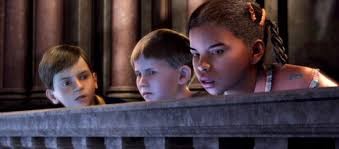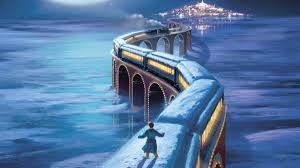The Polar Express review
The Polar Express
There comes a time in every child's life when the magic of Santa Claus comes into question. For a film like "The Polar Express," this premise serves as the foundation for a sentimental journey wrapped in an aura of whimsy and enchantment. The movie, directed by Robert Zemeckis, takes us on a thrilling ride full of unexpected twists and delightful revelations without succumbing to the typical holiday clichés. It is a story that has managed to capture the imaginations of audiences young and old, providing a perfect blend of adventure and nostalgia.
When I sat down to watch "The Polar Express," I was immediately drawn into its unique world, which is both haunting and mesmerizing. The film invites not only children but also adults to revisit the feeling of belief and wonder that often fades as we grow older. It transcends the genre of Christmas movies by offering something more profound, a tale that does not merely tell but compels you to experience the journey alongside its characters.
Background and History
The film is based on the 1985 children’s book by Chris Van Allsburg, and fans of the book will recognize its influence from the very first scene. This history gives the movie a literary foundation that adds depth to its visual splendor. Those familiar with Van Allsburg’s rich illustrations will find themselves in familiar territory as the adaptation stays true to the book's themes and essence.
Robert Zemeckis, known for his innovative use of technology in film, uses performance capture to blend the magical with reality. This was a cutting-edge technique at the time, merging live-action performances with computer-generated imagery to breathe life into the intricate world of "The Polar Express." The result is a distinctive visual style that sets it apart from the conventional animation of its era.
The Allure of Performance Capture
The technique of performance capture allows actors to embody their animated characters more thoroughly, and it is fascinating to see it at work in "The Polar Express." It adds a nuanced layer of realism while maintaining the illustrative quality of Van Allsburg’s original drawings. Tom Hanks provides multiple performances in this film, proving his versatility by voicing several pivotal characters, including the conductor and Santa Claus.
From my perspective, this process grants the film a magnetic quality as it bridges the gap between reality and fantasy. This blend enables the characters to exist in their unique, slightly exaggerated form, making them feel both approachable and otherworldly. It's a style that demands attention and invites viewers to engage deeply with the story.
The Characters: An Ensemble of Archetypes
The characters in "The Polar Express" represent the various facets of childhood, from skepticism to wonder. The nameless Hero Boy is our skeptic, standing at the crossroads of belief and doubt. His journey becomes symbolic of every child’s quest to find their belief in the magic of Christmas.
Alongside him are Hero Girl, the compassionate friend; Lonely Boy, who embodies the pain of isolation; and Know-It-All, who represents the curiosity and obnoxiousness common in youthful exuberance. Each character complements the narrative, adding depth and complexity at every turn. Their evolving relationships also impart lessons on friendship and understanding as they navigate this winter odyssey.
The Setting: A Canvas of Imagination
The Polar Express itself is a character, alive with energy. It chugs along through landscapes that are as bold and vivid as the dreams and imagination it seeks to inspire. The train transitions from snowy suburban streets to mountainous terrains, offering breathtaking views that amplify the sense of adventure.
At the story's pinnacle lies the North Pole, crafted with the nostalgia of early 20th-century industrial towns. Its towering structures and meticulous details, although somewhat austere, lend an air of enthralling mystery and grandiosity. The aesthetics of these settings create a playground for the senses, overwhelming in scope and meticulous in detail.
The Music: A Symphony of Festive Tones
The film’s score, composed by Alan Silvestri, adds another dimension to the story. Each note dances with festive cheer, sometimes even stealing the limelight from the visuals with its emotive power. The music weaves seamlessly into the storytelling, like the carols that bring Christmas to life each year.
One cannot help but be swept away by the spirited compositions, particularly during the "Hot Chocolate" sequence. The vibrant tune accompanies an equally dynamic choreography performed by the train's staff, making for a memorable harmonization of action and sound.
The Themes: Deep Waters of Innocence and Belief
"The Polar Express" digs deeper beneath the holiday surface by examining the themes of belief and innocence. Its ability to blend reality with fantasy forces us to look at our faith and our doubts critically. The film asks if we can hold onto the magic of youth as we transition into adulthood, a question that resonates with viewers across generations.
Additionally, the film touches upon loneliness and friendship, urging us to recognize the value of companionship and empathy. Through Lonely Boy's journey, we are reminded that while material gifts are precious, the gift of connection is often more fulfilling and enduring.
The Cinematic Experience
For those fortunate enough to view it in an IMAX theater, "The Polar Express" becomes an even more immersive experience. The scale, coupled with 3D technology, catapults audiences into the heart of the action, making the adventure visceral and immediate.
I recall feeling the cold breeze of the snowy landscapes and the mighty rumble of the Polar Express as it embarked on its midnight journey. It was as if the theater disappeared, leaving me aboard the train, witnessing the magic firsthand.
Visual Storytelling at Its Best
The attention to visual detail in "The Polar Express" is truly commendable. Every scene is crafted with precision, from the reflective glint of a train hubcap to the intricate angles showing Santa's sprawling workshop. This meticulous design serves to magnify the film’s enchanting narrative.
The choice of camera angles, particularly when showcasing the North Pole, shows the scale and depth of Santa's operation without romanticizing it. This nuanced storytelling heightens the narrative without relying on dialogue alone, bringing a visual poetry that speaks directly to our imaginations.
An Unconventional Santa
This portrayal of Santa Claus departs from the typical jolly caricature. Here, Santa appears more like a dignified, industrious man, focused and sincere. He is metamorphosed into a figure of respect rather than a mere symbol of seasonal mirth.
Santa’s portrayal aligns with the film’s central tenet that Christmas magic isn’t as simplistic or superficial as we've been led to believe. There's a solemn beauty in this representation that underscores the importance of belief and sincerity, which makes it all the more poignant.
The Role of the Elves
The elves in this rendition are intriguing, with their identical faces suggesting a hive-like unity. They exude an energy reminiscent of a bustling political congregation, their expressions and tones contributing to the palpable tension and excitement.
These elves break from the traditional depictions as cheerful, round-faced characters and instead become industrious participants in Santa’s grand operation. Their collective presence adds a layer of eccentricity and even foreboding, enhancing the film’s whimsical tension.
A Different Kind of Adventure
The film’s adventurous elements are not limited to grand set pieces. They are intricately woven into the emotional fabric of the story. We see this in the way Hero Boy grapples with his beliefs, his polar quest mirroring his internal journey toward acceptance and understanding.
This introspective underside of "The Polar Express" offers a journey that goes beyond physical landscapes. It speaks to our individual quests, sparking reflection and self-exploration, reminding us that the greatest journeys are often within.
My Personal Impressions
As I watched "The Polar Express," I was struck by the film's emotional honesty. It does not shy away from presenting Christmas as something complex and multifaceted, a time of year when emotions can run high, revealing vulnerability alongside joy.
This quality resonated deeply with me. It felt refreshing to engage with a film that honors the bittersweet aspects of the holiday season while still celebrating the core magic and wonder that makes it special. It invites us to embrace the fullness of our emotions, to cherish even the shadows that dance around the Christmas lights.
Conclusion
"The Polar Express" is not just a movie; it's an experience. It captures the magic of Christmas in ways that surprise and move me, rekindling the sense of wonderment and belief that we often lose with age. Its artistic brilliance, achieved through masterful visual storytelling and layered performances, doesn’t merely tell a story but rather beckons us to become part of one.
In closing, if you haven't yet made this journey, I urge you to board "The Polar Express." It offers more than the thrill of a seasonal watch. It’s a profound reminder that magic isn't confined to a season—it’s something to carry with us throughout life. Much like the conductor’s advice to Hero Boy, I think everyone should take the ride. After all, the true miracle of belief lies in opening your heart and imagination to the possibilities that lie beyond the ordinary.



To download the app, you will get links to the Official Website and/or official digital markets.
